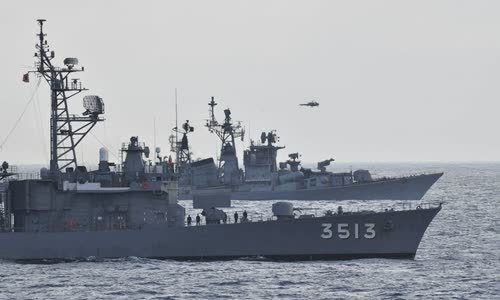India and Japan joint naval exercises between the two countries are tense with China, seeming to show sympathy to their opponents.
Indian and Japanese warships carried out exercises on the Indian Ocean on June 27, described by the Japan Maritime Self-Defense Force (JMSDF) as "to promote mutual understanding".

Two training ships JS Kashima and JS Shimayuki of the Japanese Navy during a drill with India on June 27 Photo: Twitter/
Meanwhile, Vice Admiral Pradeep Chauhan, director general of the National Maritime Foundation of India, said the navies of the two countries "were not there for combat purposes, but for signaling".
India and Japan regularly conduct joint exercises and this is the 15th joint naval exercise in the past three years.
On June 15, Indian-Chinese soldiers scrambled in the Galwan valley, in the Ladakh region of the Himalayas, along the disputed border between the two countries, killing 20 Indian soldiers.
Ishigaki City Council in Okinawa province of Japan on June 22 passed a bill to change the name of the administrative area of this island group Tonoshiro Senkaku.
The joint exercise between India and Japan is the latest sign that geopolitical competition is increasingly fierce in the Indian - Pacific Ocean.
According to analysts, Beijing's aggressive attitude in the South China Sea and East China Sea has pushed Tokyo and New Delhi together.
Since then, the two countries have intensified their military cooperation, taking part in events such as the "Dharma Guardian" land exercises, "Shinyu Maitr" in the air, or the "Malabar" naval exercise.
Prime Minister Abe and his Indian counterpart Narendra Modi also meet regularly.
However, according to analyst C Uday Bhaskar, a former Indian naval officer, although New Delhi and Tokyo are both concerned about Beijing's aggression, they remain "cautious in promoting security relations."
"The two countries share a common vision for freedom of navigation, but it is still at a diplomatic - political level," Bhaskar explained.
"This is not a signal of escalation of conflict. In fact, it is a reminder that the use of diplomatic channels to solve problems will be best for China and other countries," he said.
Some analysts also noted that the increase in activity in the Indo-Pacific region also showed the return of the Quartet, an informal strategic military group including the US and Japan.
Former ambassador Bhatia said that China's increased aggression could strengthen the Quartet.
"That's why operations in the Indo-Pacific are just beginning. This will become the most important strategic region for the US, Japan, India and China in the next decade and beyond.
New Delhi is also thought to be increasingly aware that the maritime sector is key to Beijing's escalating actions.
"The maritime sector offers certain options to curb China's growing aggression strategies, whether in relations with India or any other Indo-Pacific region.



 Balsem Mosbah
Balsem Mosbah







